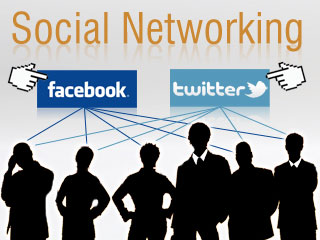 Social networking has many definitions, but in essence social networking is simply building groups (essentially an online community) with common interests. These groups can comprise your friends, family, professional contacts or even people you have never met face to face. Watch Social Networking in Plain English for a more detailed explanation.
Social networking has many definitions, but in essence social networking is simply building groups (essentially an online community) with common interests. These groups can comprise your friends, family, professional contacts or even people you have never met face to face. Watch Social Networking in Plain English for a more detailed explanation.It is precisely the social, informal communication aspect of social networking sites that can worry some management or information technology areas. Please speak to your manager or read your social media policy before participating in this week's tasks.
Facebook (view site) and Twitter (view site) are currently two of the most active social networking sites, but each are quite different in their approach, so this week we are looking at both sites.
Facebook is the largest social networking site today. According to a recent press release, Facebook has more than 500 million active users, 50% of which log on to Facebook in any given day. The average user has 130 friends and people worldwide spend over 700 billion minutes per month on Facebook.
Many libraries and library workers already have a presence on Facebook:
- State Library of Western Australia
- University of Western Australia
- Ellenbrook Community Library
- Mo-brarians
- A list of Top Ten North American Library Facebook pages
Facebook does however have privacy issues. The privacy settings change regularly and it can be difficult for a new user to keep up. The safest option is to post online only those thoughts and photos that you are happy for your spouse, mother or work manager viewing. The Australian government's CyberSmart website also has some good general advice. Those with more concerns may also wish to look at this post on Risk Reduction Strategies for Facebook.
Discover #1: Facebook has a number of different sections for personal, group and corporate uses. In this course we will set up a basic personal account. If you do not already have a Facebook account, Facebook for Gownups Part 1 will show you how to join.
Explore #1: Using the procedures set out in Facebook for Beginners, write a message on your wall, add your library's Web 2.0 Facebook course page as a friend and then send us a personal message. Yes, we have set up Midland Library as a personal account for training purposes only :)
Write a blog post this week about your thoughts on Facebook and how you think this could be used at work. If you wish, you can include your Facebook name in your blog if you want other people in this course to "friend you" - this is completely optional.
Twitter is a place where people answer the question, "What are you doing now?". Every time you answer that question in 140 characters or less - via the Twitter website, SMS, email, instant messaging or other Twitter client - it posts to your Twitter account. Posts are publicly viewable on the Twitter time line or can be made viewable just to your "followers". Twitter gives you the chance to publish your thoughts quickly or to tune into the thoughts and information streams of other users from around the world. Twitter posts are ideal for making single points or sharing a single piece of information, like a link, instantly. Watch Twitter in Plain English to see how it is used.
Twitter is at the same time, completely trivial and extremely powerful. Yes you can discuss your breakfast habits or tweet that you are running late for work, but you can also tweet links to web pages and articles that you found inspiring or profound; Twitter will break news stories faster than mainstream media. Read this article on Twitter and the Chile earthquake.
Libraries using Twitter
1 October 2010 was #followalibrary day on Twitter. This is a list of 29 Australian libraries who use Twitter as a professional communications tool, including Cockburn Library and Victoria Park Library!
Librarians using Twitter
Well, frankly there are a lot of us! A good starting place is this list of over 200 librarians, compiled by Sue Cook, CSIRO (here in Perth).
You can also make is easier for people to search for information about an event or organisation by using #tags (hash tags). For example if you are tweeting about this course use #WAWeb20.
Discover #2: Search Twitter for what is being written about libraries (you may need to try a few different search terms) and another subject of interest to you.
Explore #2:
- Visit Twitter and sign up for a free account. Be sure to fill out your profile information so people will know something about you.
- Follow some people, including SwanLibraries. You can click on the button "Find People" and type in your friends' names if you know they are on Twitter, or you can go to the participants list. This list will grow as more people progress through the course.
- Put your Twitter name in your blog post or in a comment to this blog post so other participants can find you and chat with you on Twitter.
- Tweet at least once a day for five days using the #WAWeb20 hash tag. You can of course tweet, re-tweet and reply as much as you want to over and above that minimum. Twitter is an interactive tool and as such the more you use it, the more you will understand it.
- Remember, as with all communication tools, play nicely :)
Next Week: Online Video...
No comments:
Post a Comment